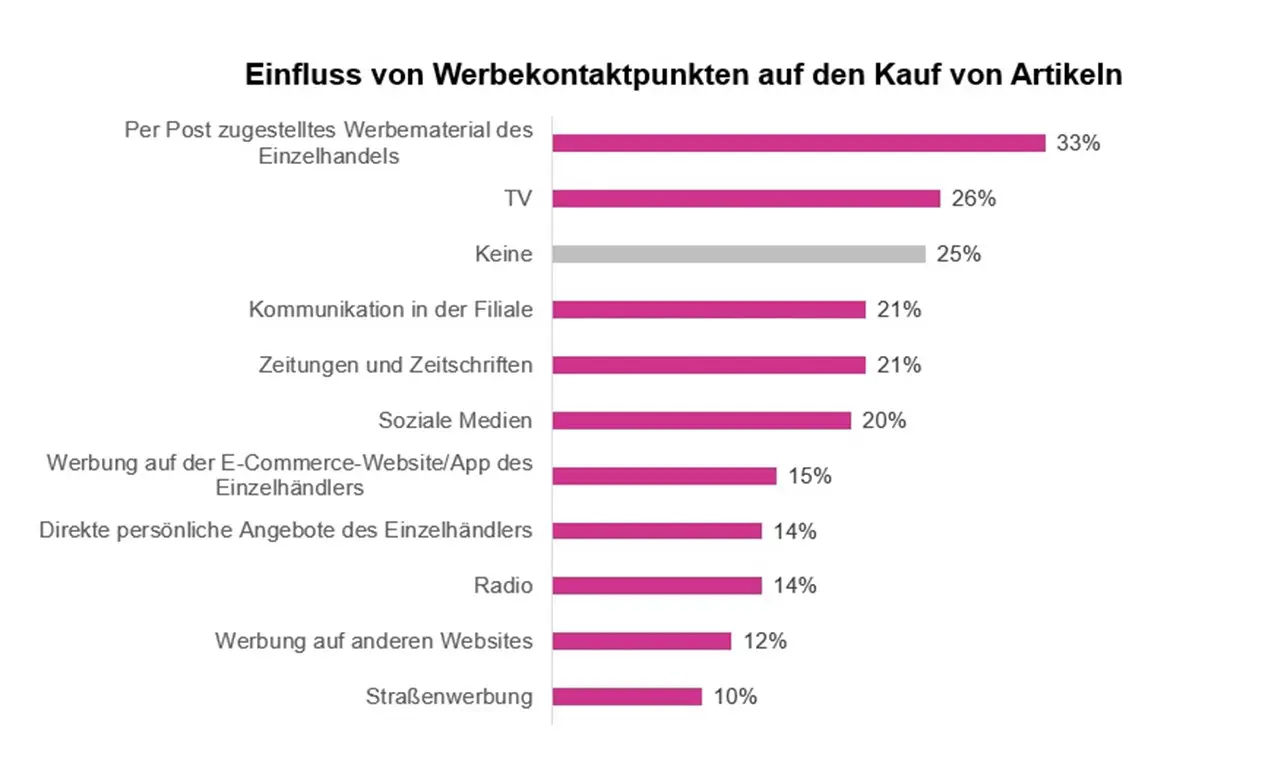Beeinflussen die verwendeten Werbekanäle tatsächlich das Kaufverhalten der Kunden?
Für jeden, der Werbeflächen bucht, ist dies eine entscheidende Frage. Unabhängig davon, ob sie sich auf Marken-, Shopper-, Performance- oder eine andere Art von Marketing spezialisiert haben, gibt es vor allem eine Frage, die sie wahrscheinlich nachts nichjt schlafen lässt: Haben die von mir genutzten Kanäle tatsächlich Auswirkungen auf das Kundenverhalten?
Leider ist dies eine der am schwierigsten zu beantwortende Fragen.
Bei so vielen verschiedenen Kanälen, die ihnen zur Verfügung stehen, sind die Vermarkter von heute auch mit einer sehr fragmentierten Messlandschaft konfrontiert. Am einen Ende der Skala stehen Messgrößen wie TV-Quoten und Druckauflagen - ungenaue, aber nützliche Indikatoren für die Reichweite. Auf der anderen Seite gibt es die präzise Media-Science, die gerade im Fall von Retail Media, eine direkte Verbindung zwischen einem Kunden, der eine Werbung sieht, und dem anschließenden Kauf des beworbenen Produkts herstellt.
Aber selbst wenn die Wirkung eines Kanals genau gemessen werden kann, sagen die Ergebnisse selten aus aus, was man gerne wissen möchte. Wenn z.B. ein Kunde einen Social-Media-Beitrag sieht, in dem für ein Softdrink geworben wird, und er dieses Getränk dann auch kauft. Hätten er den Artikel auch ohne Werbung gekauft? Hätte er stattdessen ein Konkurrenzprodukt gekauft? War dieser Verkauf wirklich ein inkrementeller Zuwachs?
Der einzige Weg, dies mit Sicherheit zu wissen, ist die Anwendung von sehr tiefgreifender Data Science. Dank einer neuen Studie, die von dunnhumby Ende letzten Jahres durchgeführt wurde, konnten wir ein besseres Verständnis der Auswirkungen eines Kanals auf das Kundenverhalten gewinnen.
Über welche Kanäle lassen sich Käufer am ehesten umstimmen?
Der "Consumer Pulse" ist ein fortlaufendes, internationales Forschungsprogramm. Es wird nun im vierten Jahr durchgeführt, um das sich ändernde Kundenverhalten im Zuge der Pandemie zu erfassen. In den letzten Jahren wurden mehrere Forschungswellen durchgeführt, wobei jede Studie dazu beigetragen hat, die sich ändernden Bedürfnisse der Kunden zu beleuchten, da sich die Welt von Covid-19 mittlerweile zu einer Lebenskostenkrise entwickelt hat.
Während die meisten Fragen, die wir im Consumer Pulse stellen, darauf abzielen, die Einstellung der Kunden zu Themen wie Preis, Wert und Zufriedenheit zu erforschen, haben wir unsere jüngste Studie in Deutschland genutzt, um die Teilnehmer zum Thema Werbung zu befragen. Konkret wollten wir wissen, welche Kommunikationskanäle sie zum Kauf eines Produkts veranlasst haben, das sie sonst nicht gekauft hätten.
Die Ergebnisse, die in der folgenden Grafik zu sehen sind, sind überraschend. Auch wenn traditionelle Medienkanäle wie Fernsehen, Zeitungen und Zeitschriften hier eine Rolle spielen, hat keiner den gleichen Einfluss auf das Kaufverhalten wie die Werbematerialien eines Einzelhändlers, insbesondere die per Post zugestellten. Ein Drittel der Befragten (33 %) gab an, dass sie zum Kauf eines Produkts überzeugt wurden, nachdem sie eine Broschüre oder einen Flyer mit der Marke des Einzelhändlers direkt an die Haustür bekommen hatten.

Im Vergleich dazu glaubt etwa ein Viertel der Käufer (26 %), dass sie durch Fernsehwerbung zu einem Kauf beeinflusst wurden, ein Fünftel sagt dasselbe über In-Store-Media (21 %), Zeitungen und Zeitschriften (ebenfalls 21 %) und soziale Medien (20 %). Jeder Vierte (25 %) gibt an, dass er noch nie zum Kauf von etwas überzeugt wurde, was er nicht ohnehin schon vorhatte.
Wenn die offensichtliche Effektivität der Handzettel von Einzelhändlern überraschend ist, dann ist es anderseits die vergleichsweise geringe Effektivität der digitalen Medien. Nur ein Zehntel der Befragten gab an, dass sie durch Web-Anzeigen von Nicht-Einzelhändlern beeinflusst wurden (12 %), womit dieser Kanal gleichauf mit Out-of-Home-Anzeigen (10 %) liegt.
Die Wirksamkeit von Werbung hängt vom Hintergrund der Person ab
Natürlich findet nicht jeder Kanal bei jedem Publikum die gleiche Resonanz, wobei der Handzettel von Einzelhändlern ein besonders gutes Beispiel dafür ist.
Während sich Männer von dieser Form der Medien leicht beeinflussen lassen, sind es bei Frauen weitaus weniger. 43 % der männlichen Befragten gaben an, dass sie nach dem Erhalt einer Postwurfsendung zu einem Kauf angeregt wurden, verglichen mit nur 22 % der weiblichen Befragten. Bei sozialen Medien ist es umgekehrt, hier wurden 25 % der Frauen zum Kauf angeregt, verglichen mit 14 % der Männer.
Soziale Netzwerke sind auch ein besonders gutes Mittel, um ein jüngeres Publikum zu erreichen: Mehr als ein Drittel (39 %) der 18- bis 34-Jährigen geben an, dass dieser Kanal ihr Kaufverhalten beeinflusst, bei den über 55-Jährigen sind es nur 5 %. Die Ansprache älterer Käufer führt uns zurück in die Welt der Postwurfsendung (40 %), aber auch das Fernsehen (26 %) sowie Zeitungen und Zeitschriften (24 %) sind wirksam.
Auch die finanzielle Situation eines Kunden kann den Einfluss eines Medienkanals verändern. Auf die Frage, ob sie sich Sorgen um die Wirtschaft machen, antwortete die große Mehrheit der Befragten (86 %), dass dies der Fall sei. Bei diesen Käufern sind händlereigene Handzettel, In-Store-Media und personalisierte Angebote, die direkt vom Händler verschickt werden, wirksamer als bei denjenigen, die wirtschaftlich unbesorgt sind.
Zu unseren weiteren wichtigen Erkenntnissen gehören:
- Kunden, die online bestellen und sich ihre Lebensmittel von einem Lieferdienst nach Hause bringen lassen, werden stärker von sozialen Medien beeinflusst.
- Kunden mit Kindern im Haushalt werden eher durch Werbung auf Websites Dritter zum Kauf angeregt.
- Menschen, die allein leben, reagieren seltener auf Werbung als Menschen, die mit anderen zusammenleben.
Im Jahr 2020 war der digitale Kanal der mit Abstand führende Medienkanal in Deutschland; Daten deuten darauf hin, dass Werbetreibende in diesem Jahr rund 12,6 Milliarden Euro für Online-Werbung ausgaben, verglichen mit nur 5,5 Milliarden Euro für Print und 4 Milliarden Euro für lineares Fernsehen1. Direktwerbung lag mit 2,5 Mrd. Euro an vierter Stelle, wobei unklar ist, ob darin auch die Ausgaben für Kooperationen mit Einzelhändlern enthalten sind.
Klar ist jedoch, dass für jeden Werbetreibenden, der Kunden zum Kauf anregen will, einige Methoden viel effektiver sind als andere - und die Einzelhandelsmedien sind eine davon. Rewe zum Beispiel hat den Schritt vom traditionellen "gedruckten Handzettel" hin zu In-App-Kommunikation und Angeboten gewagt.
Die Zeit wird zeigen, ob dies ein guter Schritt war, aber angesichts der wachsenden Bedeutung digitaler Kanäle und der Effektivität der Closed-Loop-Messung im Rahmen des Retail-Media-Paradigmas sagen wir voraus, dass sie zwar die ersten waren, die den Wechsel vollzogen haben, aber sicher nicht die letzten sein werden. Das wirft natürlich eine weitere Frage auf: Welche anderen traditionellen Kanäle werden im Zuge der weiteren Expansion von Retail Media irgendwann an Bedeutung verlieren?
1 Advertising Industry – Germany Trade & Invest
TOPICS
RELATED PRODUCTS
Make Retail Media work for your business with Customer Data Science
dunnhumby Sphere – The Customer first platform for Retail MediaTruly understand your Customers and unlock your Customer First transformation with Strategy Development, Research & Insights and Organisation Engagement
Design the right strategy with the Customer at the centerThe latest insights from our experts around the world
Retail Media: Aus der Sicht des Käufers
Wie Shopper Insights den Erfolg im Lebensmitteleinzelhandel vorantreiben



